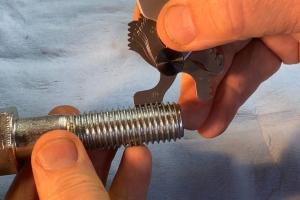Mastering the Art of Cutting Screws: Repairing Threads and Sharp Edges

-
Quick Links:
- Introduction
- Tools Needed
- How to Cut a Screw
- Fixing Damaged Threads
- Smoothing Sharp Edges
- Case Studies
- Expert Insights
- FAQs
Introduction
Cutting a screw may seem like a daunting task, especially if you're unfamiliar with metalworking or DIY projects. However, with the right tools and techniques, you can effectively cut screws to the desired length and repair any damage caused by cutting. In this comprehensive guide, we will explore the process of cutting screws, fixing damaged threads, and smoothing out sharp edges. By the end of this article, you will have the necessary skills to tackle any screw-related project with confidence and precision.
Tools Needed
Before you begin, gather the following tools:
- Screw Cutter or Hacksaw: Ideal for cutting through various types of screws.
- Dremel Tool: Useful for precision cutting and smoothing edges.
- Thread Repair Kit: Essential for fixing damaged threads.
- File or Sandpaper: For smoothing sharp edges after cutting.
- Safety Gear: Safety goggles and gloves to protect against metal shards.
How to Cut a Screw
Follow these steps to cut a screw effectively:
Step 1: Measure and Mark
Measure the length of the screw needed for your project. Use a marker to indicate where you will cut.
Step 2: Secure the Screw
Place the screw in a vice or clamp to hold it steady while cutting.
Step 3: Cut the Screw
Use a screw cutter or hacksaw to make a clean cut at the marked line. If using a Dremel tool, ensure you use the appropriate cutting disc.
Step 4: Smooth the Edges
After cutting, use a file or sandpaper to smooth any sharp edges to prevent injury.
Fixing Damaged Threads
Sometimes, the threads on a screw can become damaged during cutting or due to wear and tear. Here’s how to repair them:
Step 1: Assess the Damage
Inspect the screw threads to determine the extent of the damage.
Step 2: Use a Thread Repair Kit
Follow the instructions on the thread repair kit. Typically, this involves using a tap to re-thread the screw.
Step 3: Test the Repair
Ensure that the screw can be threaded into the respective hole without resistance. If it does not fit, repeat the process.
Smoothing Sharp Edges
Sharp edges can pose a safety risk. Here’s how to smooth them out:
Step 1: Identify Sharp Edges
After cutting, identify all sharp edges that need smoothing.
Step 2: File or Sand
Use a metal file or sandpaper to gently smooth the edges. This will ensure safety during handling.
Case Studies
Let's take a look at some real-world examples where cutting screws and repairing threads were crucial:
Case Study 1: DIY Furniture Assembly
A homeowner needed to cut screws to fit a custom-built furniture piece. By following the steps outlined in this guide, they achieved a perfect fit and avoided injuries from sharp edges.
Case Study 2: Automotive Repairs
In a repair shop, a mechanic frequently encounters damaged threads on screws. Using a thread repair kit, they can save time and resources by restoring screws instead of replacing them.
Expert Insights
We spoke to several DIY enthusiasts and professionals about their experiences with cutting screws and repairing threads:
“Always wear safety gear when working with metal. A simple mistake can lead to serious injuries.” – John, a professional metalworker.
“Investing in a good thread repair kit can save you a lot of hassle in the long run.” – Sarah, a DIY expert.
FAQs
1. Can I cut screws with regular scissors?
No, scissors are not designed for cutting metal. Use appropriate cutting tools.
2. What is the best tool for cutting screws?
A screw cutter or hacksaw is recommended for cutting screws.
3. How do I repair threads on a screw?
Use a thread repair kit to re-thread the screw as per the kit instructions.
4. What safety gear should I wear?
Always wear safety goggles and gloves to protect yourself from metal shards.
5. Is it difficult to cut screws?
With the right tools and technique, it can be straightforward.
6. How can I smooth sharp edges after cutting?
Use a metal file or sandpaper to gently smooth out sharp edges.
7. Can I use a Dremel to cut screws?
Yes, a Dremel tool with a proper cutting disc can be used for precision cutting.
8. What to do if the screw is too short?
If the screw is too short, consider using a longer screw or adding a washer to fill the gap.
9. How do I know if a screw is damaged?
Inspect the threads and the head of the screw for any deformities or rough edges.
10. Are there any alternatives to cutting screws?
Using adjustable screws or other fasteners can eliminate the need to cut.
Conclusion
Cutting screws and repairing them is a valuable skill for any DIY enthusiast or professional. With the right tools and techniques, you can extend the life of screws and improve your projects. Remember to always prioritize safety and take your time to ensure precision. Happy DIYing!
References
- Wood Magazine: Choosing Screws
- Popular Mechanics: How to Repair Threaded Holes
- Woodworkers Source: How to Fix Stripped Screw Holes
- Family Handyman: Repair Stripped Screw Holes
Random Reads
- Mastering the art of reading schematics
- How to send fireworks on iphone
- When will google street view cars visit
- How to hard reset an iphone
- How to be secure
- Remove oil from hardwood floor
- Remove pages from pdf
- How to turn a radiator off
- How to trust pc or mac on iphone
- How to create a paint booth in your garage